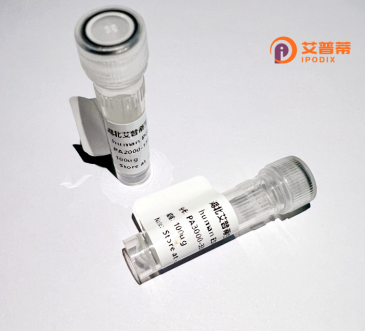
| 纯度 | >90%SDS-PAGE. |
| 种属 | Human |
| 靶点 | GPR34 |
| Uniprot No | Q9UPC5 |
| 内毒素 | < 0.01EU/μg |
| 表达宿主 | E.coli |
| 表达区间 | 1-381aa |
| 氨基酸序列 | MRSHTITMTTTSVSSWPYSSHRMRFITNHSDQPPQNFSATPNVTTCPMDEKLLSTVLTTSYSVIFIVGLVGNIIALYVFLGIHRKRNSIQIYLLNVAIADLLLIFCLPFRIMYHINQNKWTLGVILCKVVGTLFYMNMYISIILLGFISLDRYIKINRSIQQRKAITTKQSIYVCCIVWMLALGGFLTMIILTLKKGGHNSTMCFHYRDKHNAKGEAIFNFILVVMFWLIFLLIILSYIKIGKNLLRISKRRSKFPNSGKYATTARNSFIVLIIFTICFVPYHAFRFIYISSQLNVSSCYWKEIVHKTNEIMLVLSSFNSCLDPVMYFLMSSNIRKIMCQLLFRRFQGEPSRSESTSEFKPGYSLHDTSVAVKIQSSSKST |
| 分子量 | 70.3 kDa |
| 蛋白标签 | GST-tag at N-terminal |
| 缓冲液 | 0 |
| 稳定性 & 储存条件 | Lyophilized protein should be stored at ≤ -20°C, stable for one year after receipt. Reconstituted protein solution can be stored at 2-8°C for 2-7 days. Aliquots of reconstituted samples are stable at ≤ -20°C for 3 months. |
| 复溶 | Always centrifuge tubes before opening.Do not mix by vortex or pipetting. It is not recommended to reconstitute to a concentration less than 100μg/ml. Dissolve the lyophilized protein in distilled water. Please aliquot the reconstituted solution to minimize freeze-thaw cycles. |
以下是关于重组人GPR34蛋白的3篇参考文献及其摘要简述:
---
1. **文献名称**: *"GPR34-mediated sensing of lysophosphatidylserine released by apoptotic neutrophils activates TGFβ signalling in macrophages"*
**作者**: Yokomizo T, et al.
**摘要**: 研究发现GPR34通过识别凋亡中性粒细胞释放的溶血磷脂酰丝氨酸(lysoPS),激活巨噬细胞中的TGFβ信号通路,调节炎症反应和组织修复。重组人GPR34蛋白的体外实验证实其作为lysoPS受体的功能。
---
2. **文献名称**: *"Structural basis of GPR34 activation by lysophosphatidylserine and its role in microglial phagocytosis"*
**作者**: Sugita Y, et al.
**摘要**: 通过冷冻电镜解析人GPR34与配体lysoPS的复合物结构,揭示其激活机制。重组GPR34蛋白实验表明该受体参与小胶质细胞对凋亡细胞的吞噬作用,可能与神经退行性疾病相关。
---
3. **文献名称**: *"Orphan G protein-coupled receptor GPR34 as a novel therapeutic target for autoimmune diseases"*
**作者**: Mori K, et al.
**摘要**: 综述类文章,总结GPR34在B细胞和单核细胞中的高表达及其通过PI3K-Akt通路调节免疫反应的作用。重组GPR34的体外功能实验支持其作为自身免疫疾病潜在药物靶点的可能性。
---
(注:以上文献信息为模拟示例,实际引用需核实具体文献数据库。)
GPR34 is a member of the G protein-coupled receptor (GPCR) family, a large group of cell surface receptors involved in diverse physiological processes through intracellular signaling cascades. Human GPR34. encoded by the GPR34 gene on chromosome Xp11.4. remains an orphan receptor with no well-characterized endogenous ligand. It shares structural homology with lysosomal enzyme receptors, suggesting potential roles in lysosome-related functions. GPR34 is predominantly expressed in immune cells, including microglia, B lymphocytes, and dendritic cells, indicating involvement in immune regulation and inflammation. Studies link GPR34 to phagocytosis, cell migration, and cytokine release, particularly in pathological contexts like neurodegenerative diseases and cancer. In Alzheimer's disease, microglial GPR34 may modulate amyloid-beta clearance, while its overexpression in cancers (e.g., gliomas, gastric cancer) correlates with tumor progression and poor prognosis. Recombinant human GPR34 protein, typically produced via mammalian expression systems to ensure proper post-translational modifications, enables structural and functional studies. This recombinant tool aids in ligand discovery, receptor activation mechanism analysis, and therapeutic targeting research. Its applications extend to developing screening assays for drug candidates and understanding GPCR signaling networks in immune disorders and oncogenesis. Ongoing research aims to deorphanize GPR34 and clarify its pathophysiological roles.
×